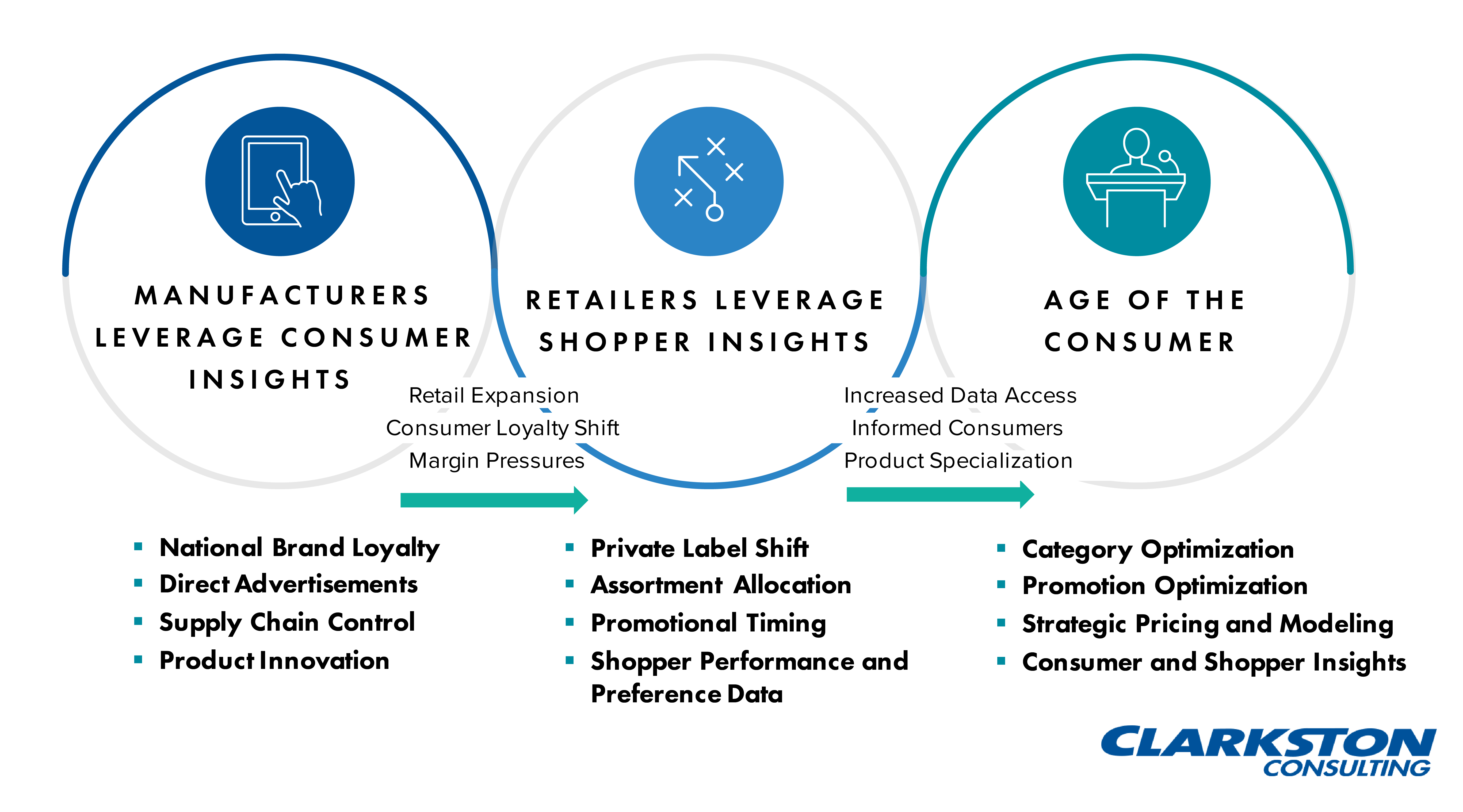2016 Consumer Products Trends Report
The consumer products industry has always been marked by change, but it is even more pronounced now in the ‘age of the consumer’. To leverage this shift in a meaningful way and truly differentiate in the market, consumer products companies need to ensure that they engage across channels, remain nimble, execute on an authentic value proposition, listen to their consumers, and quickly adapt to meet the needs of their consumers.
Download the 2016 Consumer Products Trends Report
Clarkston’s Consumer Products Practice Leader Steve Rosenstock and various Clarkston thought leaders discuss this shift and what it means to consumer products manufacturers.

Importance of the Consumer Journey
Today’s consumers are empowered in ways they have never been before. They expect to find the products they want, how and when they want them. And, with retail channels blurring in consumers’ eyes, they expect to be able to find the products they want wherever they want them. In consideration of this, consumer products companies need to take consumer expectations into account in every aspect of their go-to-market strategy. First, they need to ensure that their marketing messaging and promotional strategy extends across the multiple retail channels where their target consumers are shopping. Secondly, companies need to make sure that their products are available through all the appropriate channels, from core retail customers, to non-traditional brick and mortar outlets, to online stores.
Importance of the Consumer Journey
Today’s consumers are empowered in ways they have never been before. They expect to find the products they want, how and when they want them. And, with retail channels blurring in consumers’ eyes, they expect to be able to find the products they want wherever they want them. In consideration of this, consumer products companies need to take consumer expectations into account in every aspect of their go-to-market strategy. First, they need to ensure that their marketing messaging and promotional strategy extends across the multiple retail channels where their target consumers are shopping. Secondly, companies need to make sure that their products are available through all the appropriate channels, from core retail customers, to non-traditional brick and mortar outlets, to online stores.
Effective Marketing & Promotional Strategies
In building out a marketing and promotional strategy, sales and marketing executives need to invest in an approach to channel management that starts with a holistic view of their consumers, their expectations and their overall shopping preferences. Traditional perceptions
of what specific channels represent have changed drastically in recent years, with two examples being the large investments drug stores have made in the food and beverage category, and the focus on grocery products from big box retailers such as Target and Wal-Mart.
Beyond the changes in brick and mortar, this blurring of channels is compounded by the growth in digital, with online commerce sales up 15.2% from third quarter last year, while total retail sales increased by 1.6%.
To account for this, companies need to create personalized online and offline experiences that influence consumers as they move between channels, products and brands. In order to truly unlock the effectiveness of a consumer marketing strategy, it is critical for consumer products
companies to ensure that their trade promotional programs are properly aligned and address these changing consumer expectations. Looking at the variances between consumer marketing and trade spend, coupled with analytics to understand what spend is working effectively, companies will be able to take advantage of synergies in the market. This approach will align consumer and trade marketing tactics to create an ideal consumer experience with consistent messaging across various retail and communication channels.
Impacts of Blurring Channels
A significant impact of channel blurring and online retail growth is fragmentation of the manufacturer’s customer base. As volume shifts away from traditionally dominant accounts, it is becoming increasingly difficult to deliver efficient and low cost operations. Demand forecasts
drive the operations, and forecast error is sure to follow fragmenting demand. Many companies are attempting to develop more responsive supply networks, but that strategy is also problematic without building out timely visibility to actual demand and inventory. The design of
the distribution network itself may become sub-optimal as the weight of demand moves away from big box distribution centers.
Customer retention is a critical metric for success. According to Aberdeen, companies that maintain a consistent marketing strategy across multiple channels retain 89% of their customers, on average, compared to 33% for those with weak multi-channel marketing strategies Exceptional customer experience is becoming an expectation, and with every improvement in customer experience, a higher expectation is set. According to Gartner, customer experience management is at the top of the CEO’s agenda. Companies, such as Mattel, are working to create “personalized journeys across every stage of the customer lifecycle, from the physical store to digital experiences” with purchased product. To retain customers and maintain engagement along the customer journey, communication and alignment between front office and back office processes are becoming increasingly important.
Consumers are speaking, expectations have been set and exceptional consumer engagement is imperative. As a consumer products manufacturer, you should be asking the following questions:
- How do I effectively market within multiple channels?
- How do I effectively promote across multiple channels?
- How do I effectively manage my operations across multiple channels?
Evolution of Consumer Loyalty
Historically, loyalty has been tied to specific brands, allowing consumer products companies to dictate market trends and consequently, consumer preference through their innovation process. However, the pendulum has shifted, with loyalties quickly moving across products and forcing companies into a reactionary position.
Importance of an Authentic Value Proposition
Every consumer has their personal value proposition, which is not tied to a brand. However, while brand loyalty is more fluid and harder to predict, consumer products companies still have an opportunity to tap into consumers’ foundational value propositions in a way that could create
more enduring loyalty than among those tied to a singular brand. Specifically, an authentic value proposition that demonstrates why they are in business as opposed to what they sell, will enable companies to create new and long-standing connections with consumers.
Recognizing that shift, consumer products companies are less focused on selling brand attributes and more focused on selling the experience and purpose of their brands. As much as companies such as Johnsonville might be selling sausage, perhaps more pronounced is how they are marketing the experience that consumers have when they are enjoying a 4th of July barbecue with their friends and family. Similarly, while Moët Hennessy might be most interested in consumption of Dom Pérignon, what they are primarily promoting is the emotion of celebration and success.
To validate this point, Clarkston conducted an analysis of the commercials that companies were running during the past 20 Super Bowls. From 1998 to 2000, the vast majority of commercials and messaging was focused on the products or services being delivered. In contrast, during a similar three-year span from 2013 to 2015 companies were presenting a vastly different message to consumers; instead, they were appealing to a particular way of living, an experience or a social conscious.
Wth consumers harder to predict, successful product innovations harder to anticipate, and sales harder to forecast, organizations still need to deploy strategies to stay ahead of the quickly changing trends in the market. One strategy, to stay ahead of the market and create an authentic connection with consumers, is a relentless focus on innovation.
Focus on Innovation
Innovation can be defined and structured in various ways, including: strategic innovation, new product innovation, repurposing successful brands, acquisition through MA&D, and add-on services. Most recently, companies are co-authoring innovation by bringing consumers into the innovation process. This creates an interesting dynamic that allows companies to connect with their most engaged consumers, allowing them to experience a brand’s value proposition, and engage with them in a new way.
One example of this is the use of crowdsourcing. Unilever launched an initiative this past year called Unilever Foundry, to encourage collaboration and innovation with the broader community, aligned around its foundational value proposition: “Unilever has, from its origins, been a
purpose-driven company. Today our purpose is to make sustainable living commonplace.” This channel for innovation allows Unilever to connect with consumers on their broader purpose and influence future innovation collaboratively, challenging the changing dynamics of brand loyalty.
Innovation can also come from the ways in which companies interact with consumers. Subscription-based services are becoming mainstream, and consumer products companies are using these services as a unique way to interact with a passionate target audience. Love with Food is a service which delivers a curated box of organic or all-natural snack packages to a consumer’s door every month. The value proposition for consumer products companies includes: direct distribution to a target audience; direct feedback based on an incentive based program for subscribers; and social media engagement with a passionate subscriber base. The primary intent is to grow brand awareness and increase demand. In addition, with every box sold, the company donates a meal to food banks. Being part of such a service not only increases awareness, but gives consumer products companies an opportunity to align with partners that represents what their brand represents.
Strategically, companies are making investments to align their portfolios with their value proposition. The industry will continue to see mergers, acquisitions and divestitures. Merger and acquisition activity is ramping up in order to integrate brands that align with the organization’s overall value proposition, create new revenue in a slow growth rate marketplace, and become a more productive organization through potential economies of scale. With some companies realizing they are reaching too far outside the scope of their ability and values, divestitures can allow them to become leaner and more focused on their core competencies or invest in their top brands. Consumer products companies must strategically assess their portfolio, and its alignment with their value proposition
Click through to read the 2016 Consumer Products Outlook report which includes key trends that consumer packaged goods manufacturers will need to consider and address in the coming year, along with strategic guidance for each.



